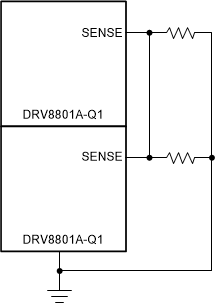SLVSC79D June 2014 – November 2020 DRV8801A-Q1
PRODUCTION DATA
- 1 Features
- 2 Applications
- 3 Description
- 4 Revision History
- 5 Pin Configuration and Functions
- 6 Specifications
-
7 Detailed Description
- 7.1 Overview
- 7.2 Functional Block Diagram
- 7.3 Feature Description
- 7.4 Device Functional Modes
- 8 Application and Implementation
- 9 Power Supply Recommendations
- 10Layout
- 11Device and Documentation Support
- 12Mechanical, Packaging, And Orderable Information
Package Options
Mechanical Data (Package|Pins)
- RMJ|16
Thermal pad, mechanical data (Package|Pins)
- RMJ|16
Orderable Information
8.3.4.3 Sense Resistor Selection
The guideline for the SENSE resistor chosen doesn't change in parallel mode. As the goal of this configuration is to evenly distribute the current load across multiple devices, each device should be configured with the same ITRIP setting. Therefore, the same SENSE resistor should be used for all devices connected in parallel.
Connection of the SENSE resistors should be as shown in Figure 8-8.
 Figure 8-8 SENSE Resistors Connection
Figure 8-8 SENSE Resistors Connection